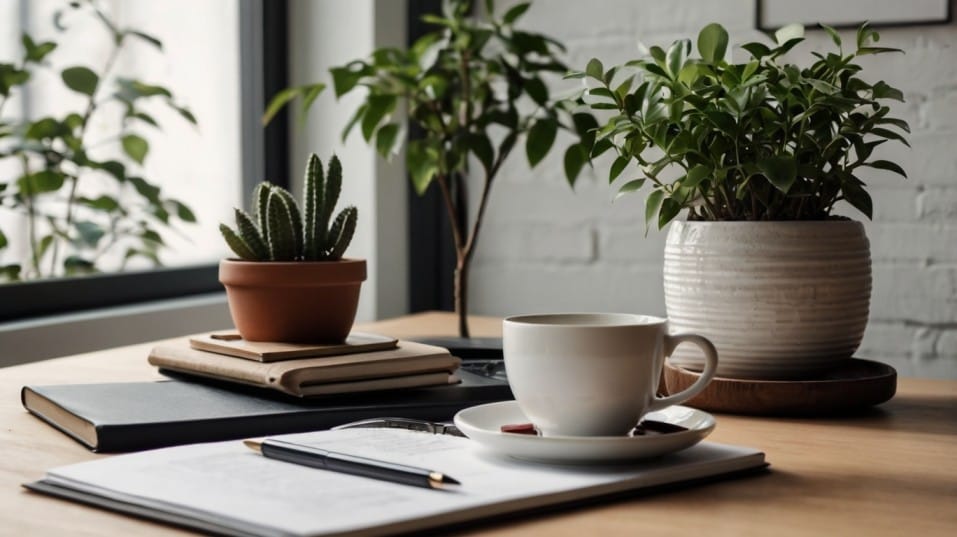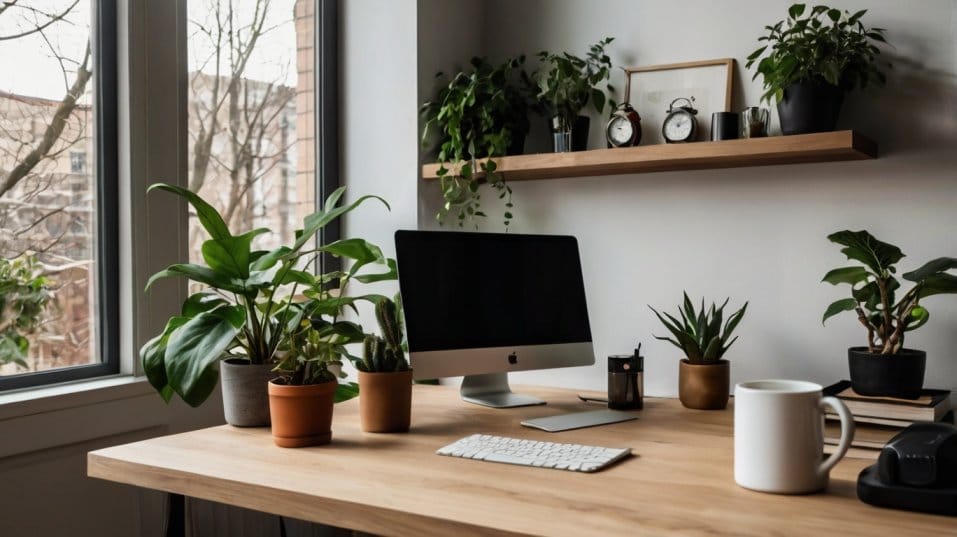How to Design a Workspace That Promotes Mindfulness
Discover how to design a mindful workspace that enhances focus, reduces stress, and improves overall well-being with simple, practical changes.

Have you ever considered that your workspace might be working against you? The way your environment is set up can subtly drain your focus, elevate stress, or even sap your motivation.
A cluttered desk breeds mental fog, while an intentional setup fuels productivity and calm. The good news? Small, mindful changes can transform your space into a haven for deep work and mental clarity—without a major overhaul.
Clear the Chaos: A Space for Mental Clarity
Clutter bombards your brain with excess stimuli, making concentration a struggle.
Research confirms that a messy environment increases cortisol, the stress hormone, while an organized space enhances cognitive function and emotional balance.
Your workspace should be a sanctuary for focus, not a breeding ground for stress. To create a sense of order, start by assessing your desk. Identify items that add value versus those that simply take up space.
Keep only essential items within reach and use storage solutions that reduce visual noise—drawer organizers, shelves, and minimalist desk trays can work wonders.
A weekly reset, where you take five minutes to clear unnecessary clutter, ensures your workspace remains a stress-free zone. A clean desk isn't just about aesthetics—it’s a reset button for your mind.

Light It Right: The Productivity Boost You Need
Lighting isn’t just about visibility; it dictates mood, focus, and overall work performance. Natural light regulates circadian rhythms, improving sleep quality and cognitive function.
A workspace bathed in natural light reduces eye strain and enhances alertness, keeping you mentally sharp throughout the day.
If your workspace lacks natural light, be strategic with artificial lighting. Opt for warm-toned lighting to create a cozy, relaxed ambiance, or use cool-toned lights for a crisp, focused environment.
Adjustable desk lamps with dimmable settings can help tailor lighting to different tasks—softer light for creative work, brighter settings for detail-oriented tasks. Experiment with different setups until you find the perfect balance.
Bring Nature In: Greenery for a Calmer Mind
Indoor plants don’t just look good—they have measurable psychological and physiological benefits. Studies show they lower anxiety, improve air quality, and boost productivity by enhancing cognitive function.
Incorporating nature into your workspace connects you to a more calming and restorative environment, even in the middle of a busy workday.
Choosing the Right Plants
Different plants serve different purposes. Snake plants are virtually maintenance-free and excellent for air purification.
Peace lilies not only add a touch of elegance but also remove toxins from the air. Aloe vera, known for its soothing properties, can increase oxygen levels in enclosed spaces.
Even if you lack a green thumb, low-maintenance plants like pothos or succulents can make a noticeable difference in stress reduction. A workspace infused with greenery feels fresher, more vibrant, and more inviting.
Sit Smarter: Ergonomics for Sustained Focus
Your workspace setup directly impacts both physical health and mental performance. Poor posture isn’t just bad for your back—it drains mental energy and can lead to chronic discomfort.
An ergonomic workspace supports your body, reducing strain and increasing concentration.
Optimizing Your Setup
Invest in a chair with lumbar support to maintain a healthy spine alignment. Adjust your monitor so it sits at eye level, preventing neck strain.
Position your keyboard and mouse so your arms remain at a comfortable 90-degree angle. Footrests, standing desks, or balance ball chairs can also improve circulation and reduce fatigue.
The more effortless your posture, the less energy your body expends—leaving more mental capacity for deep work.
Control the Digital Chaos: Cut Out Distractions
Dings, pings, and endless notifications hijack your attention, making it harder to focus on meaningful work.
Research shows that every digital interruption takes an average of 23 minutes to recover from—meaning a single distraction can derail an entire work session.
Strategies for Digital Focus
Take back control by silencing non-essential alerts, setting specific times for checking emails, and using focus-enhancing tools like website blockers or the Pomodoro Technique.
Noise-canceling headphones can also help you create a cocoon of concentration, minimizing disruptions from external noise. When you actively manage your digital space, you create an environment that supports deep, uninterrupted work.
Make It Yours: Personalization with Purpose
Your workspace should reflect your personality and inspire creativity without becoming a source of distraction. A framed photo, an inspiring quote, or a meaningful trinket can boost morale and motivation.
However, balance is key—too many decorations can create visual clutter, which works against the sense of calm you’re trying to cultivate.
Striking the Right Balance
If you work best in a minimalist environment, opt for a sleek, uncluttered desk with only a few personal touches.
If visual inspiration fuels your creativity, consider a vision board or curated artwork that sparks motivation. The goal is to create an environment that feels both functional and inspiring.
Build a Routine: Mindfulness in Action
A well-designed workspace is only as effective as the habits that accompany it. Establishing mindful routines reinforces structure, reduces stress, and helps maintain a sense of control over your workday.
Daily Mindfulness Practices
Start your day with intentionality—before diving into emails, take a deep breath or set a clear goal for the day. Incorporate structured breaks to reset your mind, whether it’s a short walk, stretching, or a moment of quiet reflection.
At the end of the day, organize your workspace for the next morning, signaling a mental transition from work mode to relaxation.
Mindful work habits not only enhance productivity but also help create a sense of balance, preventing burnout and mental fatigue.
Final Thoughts
A mindful workspace isn’t about expensive redesigns—it’s about intentional choices.
Declutter, optimize lighting, introduce nature, and manage distractions to create an environment that supports clarity, efficiency, and well-being. Small, consistent changes add up to powerful results.
Start now—choose one area to improve today, whether it’s clearing your desk, adjusting your lighting, or setting boundaries for digital distractions. The more mindful your space, the more focused and energized you’ll feel in your work.




